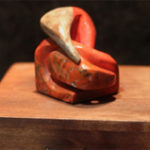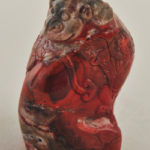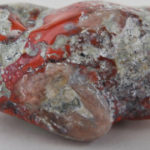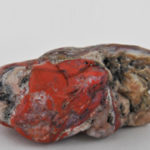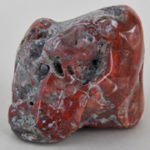The Rice Northwest Museum of Rocks and Minerals, in Hillsboro, Oregon, is proud to announce a new permanent exhibit featuring myrickite carvings, slabs, jewelry, and polished specimens, all donated by John Li of Portland, Oregon.
Myrickite is a lapidary term that refers to agatized or opalized cinnabar (a mercury mineral). It is the small quantity of mercury that gives the stone its beautiful red coloring. Myrickite is a lapidary arts term that refers to agatized or opalized cinnabar. It is named after the prospector Francis Marion “Shady” Myrick who first discovered it in California’s Death Valley in 1911. It is very similar to Chinese Chicken Bloodstone in color, but myrickite is much harder than the cinnabar stained serpentine (Chicken Bloodstone). Both myrickite and Chicken Bloodstone are considered precious materials for carvings, chops and jewelry. But myrickite is rare, and to date, less than one ton has been found and used in art stones.
Myrickite is found uniquely in the United States. It is only found overlying gold deposits. In the 1950s gold mining in the Manhattan Mine in Napa Valley, California led to the discovery of more myrickite. Roberts Minerals subsequently contracted with Homestake Gold Mining Co. (including the Manhattan Mine) for the exclusive rights to mine the myrickite. In 1982 Roberts removed 500 pounds of orange and black opalized material, and in 1983 they discovered red agatized material for the first time in a seam 30 feet long, 30 feet deep and four to five inches wide.
At the Rice Museum in our Lapidary Arts Room we have several myrickite pieces on display that are either on loan or have been donated by Mr. John K. K. Li. Mr. Li gave myrickite the Chinese name Jin Ding Hong which means bright red stone on top of gold. The piece “Our Futures Are Intertwined” a myrickite carving once destined to be a presidential gift from President Clinton during his 1988 visit to China, is featured in the photograph. Mr. Li has worked tirelessly to promote myrickite as a symbol of good fortune between the United States and China.
Some of the pieces from this collection will be featured in a joint exhibit with the Chinese Chicken Bloodstone Association in the Hong Kong Science Museum in 2014.

